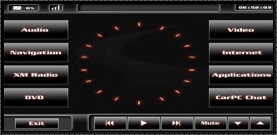Car Pc Frontend Software

Introduction Part 1 - Installation of the Car PC Part 2 - Adding a Rear-View Camera Part 3 - Time for some Software! Part 4 - An LED message sign. Is our exciting new software for Windows based CarPCs. Our exciting new Windows frontend for in car computing! PC and parts manufacturers. Customers often ask us if they need Centrafuse on their Car PC. The answer is no not all, but it is the difference between having a computer in your car and having a.
Windows Windows XP is your most flexible choice in terms of hardware and software support. Though you can run older versions of Windows, such as Windows 2000 or Windows 98, most of the car computer application development occurs on XP. Windows tends to have support for the latest multimedia features. I know that sounds very buzzwordy, but it isn't intended to be; it merely means that you get the best driver support, both hardware and software, when using the latest version of the Windows OS. If you're trying to run the latest DVD software with surround sound, a handful of video game emulators, and some 3D games, as well as supporting a number of USB networking, storage, and input devices, you'll have the smoothest experience if you run XP. One of the drawbacks of Windows XP is the way it handles new hardware. If you so much as change the USB port of a network device, GPS unit, or other similar device, Windows acts as if it has never seen that hardware before. Motorola Truesync Update on this page.
It pops up dialogs asking you to find the driver (even though it knows full well where the driver is), and then it creates a completely unconfigured 'new' entry for the device in its hardware list. This has the frustrating result of changing the COM port of your GPS unit, or resetting the 'connect to non-preferred networks' setting of a USB network card, making your GPS and networking stop working until you reconfigure them in the Windows control panel. Another Windows choice is Microsoft's embedded operating system, Windows CE. Embedded operating systems are designed to run on appliances and other special-purpose computers. The BMW 7 Series uses this OS in its navigation computer, and the Windows automotive group () is trying to get this OS into new vehicles from other manufacturers. Windows CE also powers the Pocket PC computing platform, which has gained market share over the Palm Pilot after half a decade of fierce fighting.
But while you can install applications on a Pocket PC, Windows CE alone isn't sold directly to end consumers. Embedded operating systems expect to be configured with only the necessary drivers and software, burned onto a flash disk, and run for years without any changes. While this ultra-reliability is important for an OS that might be communicating with the engine computer, it's very uninteresting for those of us who want to hack new functionality into our cars on a regular basis. Windows runs only on x86 instruction set processors, which include Intel, AMD, and VIA Eden processors. Intel's own market-leading Pentium 4 processors get notoriously hot—not an ideal condition for an in-car computer. But recently, VIA and Intel itself (with the Pentium M) have begun to make hardware that consumes tens of watts, not hundreds. While the 'real' in-car computers that auto manufacturers preinstall in their cars are unlikely to ever be x86 processors (or to run Windows XP or its successors), Windows is still one of the strongest options for in-car entertainment computing.
There are actually several different editions of Windows XP suitable for in-car computing: Home, Professional, Media Center Edition 2005, and Embedded. Windows XP Home edition is the cheapest, at less than $100 for the OEM (Original Equipment Manufacturer) version.
You can buy an OEM version of Windows when you purchase computer hardware such as a motherboard or processor, as opposed to the retail version, which upgrades your existing operating system. Windows XP Home has almost everything you need for car PC computing (despite the irony of its name), but it lacks one must-have feature found in Windows XP Pro: Remote Desktop.
When that feature is enabled, you can log into your computer remotely (say, when you go into the house after parking your car) and see the full screen, enabling you to control and configure things, run programs remotely, and so on. While there are many other remote desktop services that you can install (including VNC, at ), the one built into XP Pro is probably the most bandwidth-efficient version you can get. Windows XP Media Center Edition 2005 is essentially Windows XP Pro with a special media player application, and for an additional $30 you can get an infrared remote control designed for it. Like the OEM version of XP Home, you can purchase this in conjunction with just a minimum amount of computer hardware from a licensed vendor. Media Center can play MP3/WMA (Windows Media Audio) collections and WMV (Windows Media Video), but not DVDs—for that, you need a separate DVD player plug-in or application.